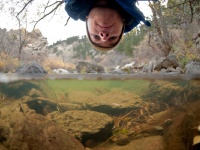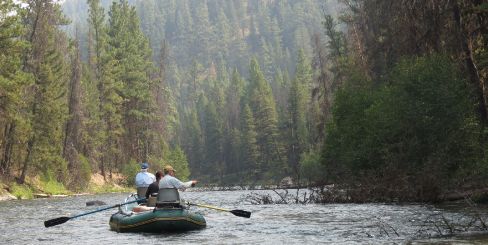You may know Colorado-based fine arts photographer, Tim Romano, from his work at venerable Field & Stream Magazine, or his former gig as photo editor at the Fly Fish Journal. But there’s a good chance you don’t know about his mission to save the world—or at least a world for a dwindling population of native cutthroat trout on the brink of extinction—or his plans to bring an old wood dory back from the dead and onto the water.
Fact is, Mr. Romano is full of surprises and he’s not afraid to speak openly on everything from conservation to the current state of flyfishing photography as it’s been hurled into the Internet age. I recently sat down with Tim to dissect just what goes into producing stand-out images that resonate amid the sea of photos bouncing off the Facebook and Instagram and Flickr and Pinterest and Tumblr and Twitter walls. It turns out the answers still boil down to hard work and extraordinary results. And those outcomes continue to be elevated. Read on.
Geoff Mueller: Fly-fishing photography is evolving at a lightning-fast pace. Across social media channels, it seems like everybody is an “instant” photographer. Is social media killing the art, or improving it? How has it affected your business?
Tim Romano: Everyone is a “photographer” of sorts these days, with phones and the digital realm making it almost effortless and the cost minimal to hardware and software that used to be only accessible by professionals. In that sense the visual world has expanded rapidly and I do appreciate that there’s so much more to look at. That’s a good thing. Unfortunately, not unlike the rest of social medial most of it is just a bunch of gibberish. If you’re talking about the photographic medium being elevated by the massive influx of hobbyists that all of a sudden consider themselves the real deal… I think not. Most of it is, as a fellow professional says, ‘fisherman with cameras that rely on parlor tricks like fisheye, highpass, and HDR to get shots that pass as anything remotely worth looking at.’ In a lot of ways it’s been an uphill battle as so many of these people are willing to simply see their names in a magazine, on a website for little or no money, or are willing to trade an image for a free rod or reel. In other ways it’s been great. The companies, agencies, and magazines that recognize professional work keep coming back and are willing to pay for higher quality photography. They don’t waste their time with the hobbyists. Not only do you have to be technically proficient as professional—the time, education, and miles put in always shows the additional depth to the work that only comes with a practiced eye.
GM: Some of my favorite shots of yours seem to effortlessly capture place better than most. Do you have a favorite series of images you’ve taken over the years?
TR: In terms of fishing and travel I think hands down it has to be the area in and around New Orleans. I’ve spent a ton of time there and have really come to enjoy the people, fishing, subtle geography, food, and culture that make it what it is. Like anything, the more you get to know a place, the more you can relate to it and create more in-depth and better photos. As for personal work, I have an ongoing series of images made over the years at our family camp in the Adirondack mountains in Upstate New York. We go every summer for a week or two and shooting my wife’s family and their retreat is really special to me.
GM: Do you ever tire of the subject matter: fish and fisherpeople? How do you keep a fresh perspective?
TR: Totally. Sometimes I despise it. Many, many times over the summer on local jaunts I simply refuse to bring a camera and just let myself fish or row and not get carried away with trying to ‘work.’ I also have a number of personal photo projects that I’m always adding to. I have a life-long project that has to do with jet contrails and aviation photography. I’m always shooting portraits, and concentrate a great deal on my family, which never grows old.
GM: Who are a handful of your favorite non-fishing photographers, and why?
TR: There are so many. Most of what I tend to gravitate toward is in the “fine art” realm I guess if you want to call it that. I have always loved some of the old school, classic black and white guys like Harry Callahan and Ray Metzker. They’ve shown a way of really shaping the world into their own little private experience. The work of contemporary German photographers Andres Gusky and Thomas Demand have had a great influence on me too due to their muted sense of color, vastness, and overall minimalism. I’ve always loved the portraiture of a Texas photographer named Keith Carter, too. I think he instilled in me the use of tilt/shift perspective before there was really any photo-shopping going on that I’ve carried with me to this day.
GM: Tell us a little about your work with the Colorado Greenbacks. In particular, I’m intrigued by the 1of750 campaign. How are we helping preserve the greenback cutthroat gene-bank for future generations?
TR: The Greenbacks are an offshoot group of Colorado Trout Unlimited and basically were put together because many of us were bored with, or had no interest in their historical chapter program. We wanted something that was more fun and engaging. We host a number of events through the year that emphasize young professionals engaging and giving money and time to conservation work. The 1of750 campaign is a movement aimed to help people recognize the plight of Colorado’s state fish: the greenback cutthroat. There are only 750 of them left in the wild and we are trying to help save them.
GM: Tell us about your boat project? And will it float?
TR: Yeah, about that. It’s going slowly. Very slowly…. Basically my good friends at Boulder Boat Works gave me what was their 15-year-old wooden prototype for what is now their super strong and sexy plastic hulls. It was rotting away in their parking lot and when I asked what it was and what they were going to do with it they quickly replied with, ‘Viking funeral.’ Not willing to let them simply burn it, I dragged it of the lot and got to work ripping it apart and restoring it last summer, basically by myself. I’ve never done anything like this and it’s been a fairly daunting task. Will it float? I’ll let you know in the spring.





